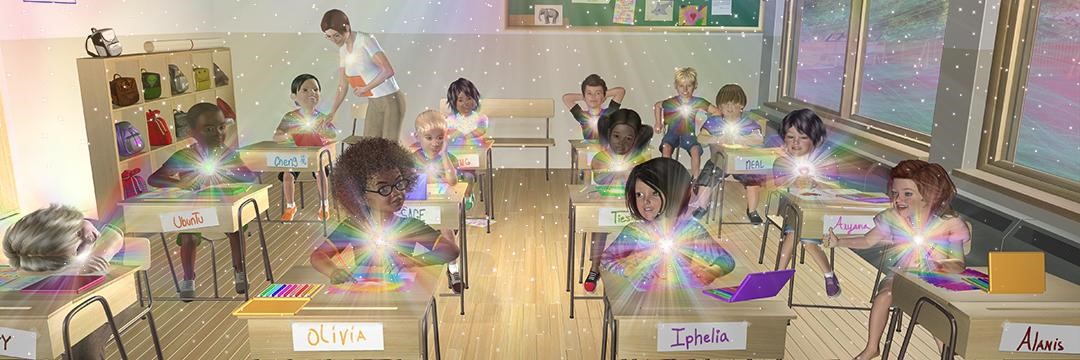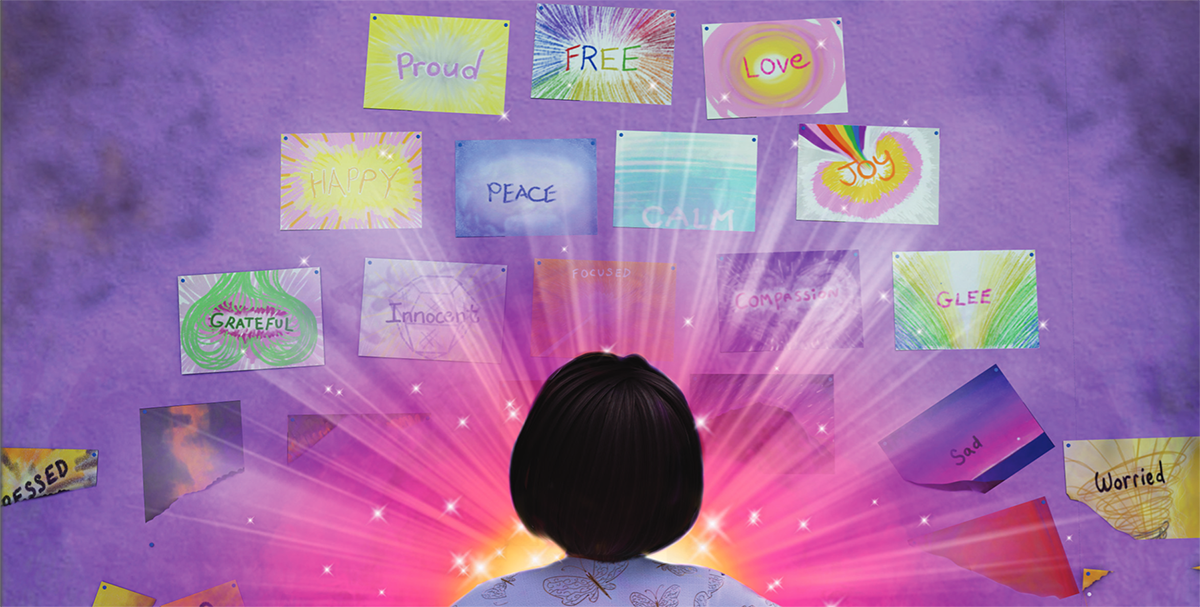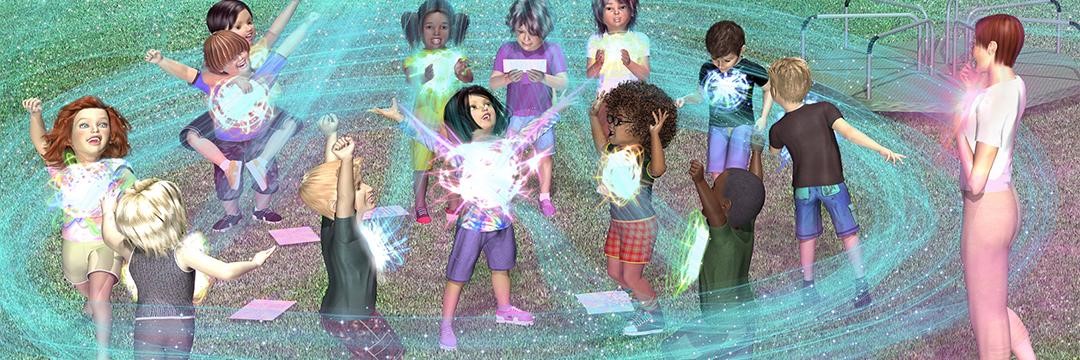
“When recess was over and the children went inside… It was a happy day for everyone—smiles were very wide.”
Friends of Iphelia may be familiar with synchronicity—the Jungian concept that some coincidences represent a meaningful “falling together in time,” like when after releasing a lot of anger then deciding to hang her favorite feelings on the wall, Iphelia has a sudden flash of insight and notices the arrangement forms a rhyme. In the next moment she comes up with a chant that brings all the feelings together, naming them and allowing her to share them with the world. She discovers the solution to her problem!

Being able to notice synchronicity is one of the gifts we give ourselves when we feel all of our feelings, but have you thought about or practiced any synchrony lately?
You or a loved one probably has, but it may not have been intentional. Does your child sing nursery rhymes in their classroom? Or maybe you have a niece or nephew in marching band. If you’ve ever clapped your hands in unison with the rest of the crowd at a concert or “made some noise” on cue to vocalize your enthusiasm for an entertainer up on stage, you’ve known the unique experience that is synchrony.
Why prioritize synchrony?
Many of us look for and are heartened by synchronistic events. We receive them as messages from the universe that bring love, light, lessons, and affirmation. We can’t will a cardinal to land on a tree in front of us, instantly stirring up memories of a mentor we associate with that particular bird, or impel a favorite soothing song to come on the radio during a tough commute. Those things just happen, and when they do, we feel they’ve occurred at just the right time, in just the right measure.
But we can make space for and prioritize synchrony.
A growing body of research indicates that participating in intentional synchronized behavior could be a key to healthier, more fulfilling engagement with ourselves and the people around us. In fact, a 2014 study published in Frontiers in Psychology found that intentional interpersonal synchrony resulted in increases in participants’ self-esteem.
Engaging in social synchrony also boosted participants’ self-other overlap, which means they quickly understood the difference between themselves and their partners as less definite as a result of participating in movement that was intentionally synchronized with their partners’. Experiences of self-other overlap are known to contribute to feelings of belongingness and increased integration of the resources, perspectives, and characteristics of another or others into the self.
So, why were smiles very wide after Iphelia’s classmates enjoyed her powerful chant on the playground?
Consider that the children’s recess included a very powerful dose of interpersonal synchrony.
And when Olivia, Neal, Tiesha, and Sage go home feeling more self-confidence, a greater sense of belonging, and less social anxiety, it stands to reason that they’ll be more likely to trust and feel their feelings rather than disassociating from or suppressing them. Imagine what kinds of synchronicity those children might benefit from after the decongesting experience of hollering out Iphelia’s chant, clapping, and dancing together.

Just like the healthy release of anger, synchrony can help us get to an emotional state in which there’s enough self love and room to notice synchronicity. It’s another practice that can help us awaken the gift of feeling.
Practicing Safe Synchrony
Still, as adults, some of us feel awkward engaging in synchronized activity, and that’s okay.
Not everyone at a concert is comfortable putting their hands up in unison or swaying their hips to the beat, even though they’d be belting the same song out with gusto in the privacy of their own shower or vehicle. In order for social synchrony to do its work on our hearts and minds, we have to find or make safe spaces to express freely.
As children, before enduring the impact of all the emotional congestion around us, most of us did express freely. We didn’t censor and we weren’t concerned with pretense. But we were concerned with survival. Because of our emotionally congested culture, many of us quickly learned to hold back, hide our feelings, and restrain our genuine spontaneous expression.
“Stop your crying or I’ll give you something to cry about,” “You’re getting too big for your britches,” “You better get down off your high horse,” “Be quiet!” and “Who do you think you are?” are all examples of how our true expression gets squashed by input that stirs our childhood fears of losing love, care, or attention. Even a parent’s inauthentic reassurance that nothing is wrong when they are actually very upset about something plants a seed of suppression. Over time, these fears and restraints become embedded into our personalities and many of us believe those qualities to be traits—innate parts of who we are. But for most of us, these are not traits. They are anxiety-driven neuroses we adopted to survive the anxiety-driven neuroses of the adults surrounding us during our childhoods. They are the result of a contagion of separation that has been infecting our family histories for generations.

All this emotional separation causes us to feel separate from ourselves and ultimately from one another. The first separation happens inside. We don’t fully process our feelings of hurt and sadness, and the more those feelings build up without healthy release, the more separate we feel from ourselves. And when we are separate from ourselves, it isn’t possible to really feel connection with others. In fact, our thoughts, words, and behaviors, informed by fear and separation, begin to discourage real intimacy and connection wherever we go.
By the time we reach adulthood, the internal and interpersonal separation of our childhoods has had a huge impact on how we think of ourselves—both our minds and bodies—and how we feel in relation to others. Without even realizing it, many of us doubt what we like, our decisions about who we spend time with, and even how our bodies look and move. We fear being found out as less than, different from, or not as worthy as the others around us. The woman standing stiff at a concert may have deep-seated feelings of awkwardness about her body, or stressful memories of exclusion from activities that were meant to be fun in elementary school. The guy staring down at his phone, instead of clapping his hands on cue, rebels to compensate for the belittling experiences of powerlessness in his past. For him, participating in intentional synchrony means bending to someone else’s authority, so he finds a way to disengage instead of leaning in and feeling free.
Still, we have within us a natural impulse to engage in interpersonal synchrony. Children who feel safe seek ways to synchronize. They sing and dance and clap together, spin in circles and laugh together. We all want to feel connected and free. We see children playing this way in the distance and for a moment our hearts remember. Then we put our heads down and go back to work, back to our problems—problems which ultimately began with our emotional congestion.
And what about when children shy away from or avoid engaging in interpersonal synchrony? For example, what if Cheng opted to sit on the swings alone while the other children enjoyed the chant, or Aryana decided to sing another song at the top of her lungs instead of joining in unison? Young children who avoid connection and synchrony are more than likely symptomatic of a larger problem that is happening in their native environment. As an adult in their lives, you may be in a position to make room for their tears, anger, and fear in order to help them grow into the self love and trust that allow for healthy participation. Even the tiniest congested hearts may need to have healthy release before they can join the chant.
Serving Up Synchrony
There are lots of things we can do to incorporate the experience of healthy synchrony into our lives. All shared activities have some degree of synchrony at play. Daily rituals like meal times, reading time, and bedtime encourage synchrony. But the more overtly synchronized and intentional it is, the more powerful the activity will be. Things like synchronized exercise, dance, chanting, songs, concerts, meditations, and prayer are examples of powerful intentional synchrony. In all cases, the most effective and most powerful practice to support children in the experience of synchrony is to BE SAFE.
The first and most important place to be safe is within the self. We have to become aware of the child self within and begin paying attention to him or her. This means making safe space and taking adequate time to feel our feelings without self judgement or shame. We have to get to a place where we can feel care and compassion toward ourselves in response to whatever bubbles up. Only after we have begun to heal the relationship with our child self—that little person who may be desperately craving or fearfully running away from synchrony—do we become genuinely capable of providing safety for others, including our children.
Be safe for children. Strive to be truly non-judging and accepting. In order to create space for safe synchrony, you have to lead the way by paying attention to your own feelings and making sure you are finding safety for yourself. This is how you can be a presence, radiating safety around you with your calm, with your enthusiasm for the activity, with your acceptance that everyone will engage differently. Be the thing! Pay attention to what you are being in your essence. People feel it. Children feel it. Even if they are not consciously considering whether or not they are safe, children feel feelings that affect their perceptions and behavior. Then sing or chant. Dance. Drum. Clap. Face your own fears and give others inspiration to face theirs.

Our hearts, minds, and bodies are all meant to experience synchrony and synchronicity. There is nothing more powerful you can do than be a safe and harmonious presence—serving yourself and the world by making space for feeling.
This article refers to Iphelia: Awakening The Gift of Feeling, a graphic novel for the inner children of grown men and women. It is the story of a girl born with a special gift of sensitivity, told through 90 pages of visually stunning images that animate the feeling-level of experience through color, texture, shape and motion, making it perfect for young children, too. Iphelia is on the web at www.iphelia.com and www.ifeelya.com, or visit her on Facebook @iphelia.

